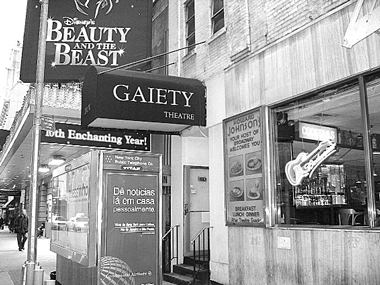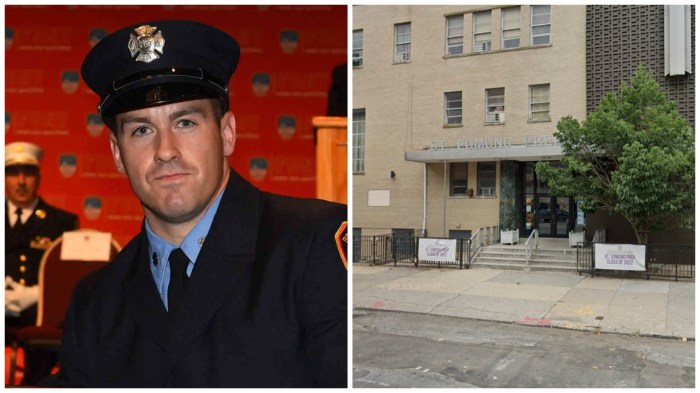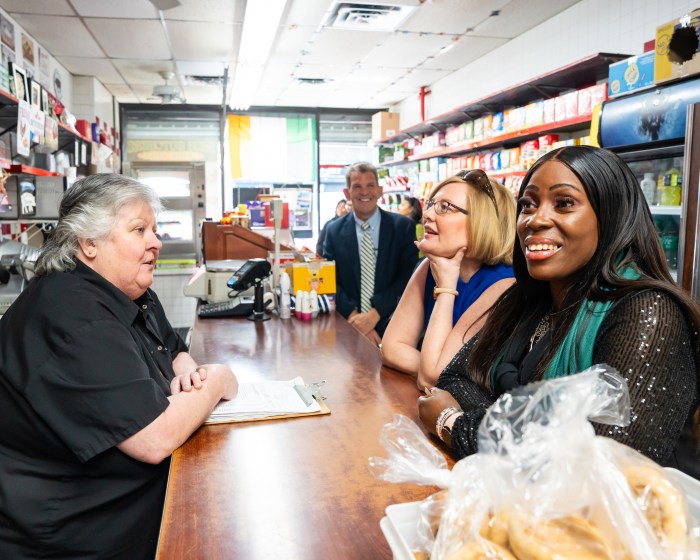An era ends with the closing of a gritty, wonderful male strip joint
On Thursday, March 17, the curtain went down on one of Broadway’s last cultural institutions from the gritty, bad old days.
As New York City firemen and other worthies strutted their stuff up Fifth Avenue to the tune of St. Patrick’s bagpipes, across town another group of men were dancing to a different tune for the last time on the divey stage of the Gaiety Burlesque at 46th Street and Broadway. Grinding in their scanties before an audience of mostly older men, with a sprinkling of younger, married-looking stockbroker types in suits and ties and the odd female or two, an endless parade of young male hunks had dollars stuffed into their g-strings for the last time.
How the club managed to survive as long as it did is anybody’s guess; and exactly how long it had been there is also a matter of debate among aficionados, but for more than 40 years customers climbed narrow stairs to the third floor above Howard Johnson’s to pass through a turnstile into a dimly-lit theater which featured one thing—men dancing, stripping and performing various acts of unfettered erotic expression.
Word on the street has it that the building is being sold, but whatever the reason, beauties from Rio and Montreal together with homegrown American lads danced their last dance and will have to move on. The final evening at Gaiety was not without its sad moments. A burly security guard burst into tears at the prospect of losing his job and even the hard-as-nails owners, a pair of ladies straight out of “Never on Sunday,” seemed more like distraught grandmothers than Lizzie Bordens. The dancers seemed a bit lost too and spoke about Vegas and South Beach as destinations of opportunity.
The beauty of the Gaiety was that you could go in anytime and stay as long as you liked. Shows, if you want to call them that, began in the morning and continued into the small hours. For a modest fee—the price had gone up over the years from a couple of bucks to $20—non-stop entertainment was provided. Back-to-back dance numbers usually lasted a couple of minutes and were mostly solo performances, typically animated by recorded pop tunes. While the choreography varied, with occasional attempts at “serious” movement of the Martha Graham variety, the routine was usually bump and grind and always ended the same way. As the song wound down, the dancer would move close to the edge of the stage, mobilize an erection and wait for a shower of dollar bills from ringside customers. Back in the old, palmier times, audience “participation” was encouraged and during intermissions in the lounge area where free punch and snacks were served, dancers would mingle with guests making dates for a rendezvous later in the evening, usually at nearby hotels.
Many in the audience were regulars who had been loyal customers for years. There was the “professor” who would arrive with a bottle of wine and a glass and sip burgundy as he watched the passing parade on stage. “Mr. Binoculars” was another hardy perennial who always sat in a prime seat in the middle of the front row with his opera glasses trained on the dancing talent. Most awaited was “Mr. Big Bucks,” a portly, aging gentleman who would waddle to a special seat on the edge of the stage and throw packets of freshly minted dollars at his favorite dancers, creating a virtual blizzard of money which was quickly scooped up by sweepers with brooms and dust bins.
Gaiety’s stable of hoofers offered an impressive selection of dancers. There were all types of guys—tall, short, black, Asian, Latino, white, clean-cut, rough trade—and lots of them. Each weekday featured a shift of dancers and on weekends the shift doubled. Every week for five weeks brought a new selection of faces and bodies. Then the cycle repeated itself. Discriminating, regular customers were in the habit of calling the box office on Monday mornings. The phone was invariably answered by the gruff-voiced Denise who would growl out a run-down of the coming week’s menu—“OK, Honey, we got Carlos, Taylor (he’s a cutie, doll, just in from Montreal),Valerio (you’re gonna like what ya see on that one), Sergio, Lincoln, Billy and Johnny Wong.”
Gaiety lore had it that Patrick Swayze once graced the boards as a dancer and that Shirley MacLaine had been sighted in the audience. And everybody buzzed about the visits of Madonna who was said to come there to recruit dancers for her productions. One stud, who called himself Rocky Balboa, even claimed to have been her boyfriend.
Best of all, real friendships were made at the Gaiety. The Saturday night crowd of old-timers became club-like and people got together outside of the theater. When somebody passed away, the lounge would become a mourning room with dancers in their thongs commiserating with geezers about the recently departed.
Of course, nobody was “gay.” The dancers were there just for the money and the oldsters all belonged to a generation that didn’t recognize “pansies” as real people. Everybody was comfortable with their illusions, and the dimly-lit hall made it all seem real.
Where will everybody go? The clients and the dancers? The hopeful buzz is that the Gaiety will re-surface somewhere else, possibly along the West Side Highway. But given the relentless march of clean-cut gentrification in the neighborhood and the Internet’s inroads into the porn industry, it will be hard for an up-standing strip joint to find a sleazy new home in these parlous times.
gaycitynews.com





























